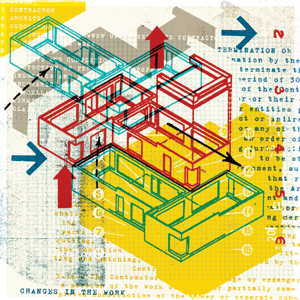When a small project grows, you may face compensatory and consequential damages.
Like poison ivy on a job site in the summer, an architect’s legal obligations to the owner can sometimes grow overnight. This phenomenon is well known as “scope-creep” to us lawyers who solve problems for design professionals. A classic example is the kitchen/bathroom renovation that grows and grows when the owner decides he or she wants to do a gut renovation of the entire house with you running the show. What a boost to the ego, (and one’s bank account). But wait. You probably documented your scope of work at the outset in a fee proposal with a short work description. You didn’t feel any need to worry about providing detail in that letter about construction administration services or about limiting your potential damages. After all, what could go wrong with such a small interior project? If things are moving along smoothly as the project expands, why get involved in the potentially unpleasant task of negotiating a revised agreement that reflects the realities of the increased scope of work? Besides if anything goes awry, it will all be sorted out amicably at the end. Right?

Wrong. Your letter of agreement needs to be changed or amended to reflect what is actually happening with the project. For example, suppose the scope-creep involves an excavation you hadn’t previously provided for and leads to a question about buried utilities in an area that has been added to the scope of your responsibility. The excavation contractor proposes to look into the matter by checking filed plans from previous projects and by calling the local “one-call center”—one of the notification services that operators of buried pipelines, power lines, and other underground facilities have jointly established throughout the United States as clearinghouses for information about buried lines. You aren’t even involved at this point.
But you are. You’re the architect on the project. If one of the contractor’s employees severs a buried electrical line and causes a fire or, worse, dies from electrocution, you are likely to find yourself caught up in a protracted, emotionally draining lawsuit. Your supposed lack of diligence in being sure that all buried lines have been identified will be subjected to scrutiny, and may even be assessed by a judge or jury with little feel for the practicalities of construction or for what an architect actually does. You, the architect, become more accountable than the contractor, who argues that he is just following your plans. And if your plans lack a warning later found to be necessary? It can mean trouble. Scope-creep requires you to think differently, and more intensely, about the greater detail and need for self-protection that goes with expansion of the size and complexity of the project.
In the construction industry, the risk of consequential damages can amount to a kind of scope-creep. In addition to the compensatory damages you could face for loss or injury if you lose an arbitration or court case, you might also be hit with consequential damages—the term for payment ordered by a court or arbitrator for losses that result indirectly.
This may include the loss of expected profits. In one well-known case, a contractor’s delay in the partial renovation of a casino meant that a glass facade due in May wasn’t substantially completed until August. The aggrieved owner terminated the agreement and brought an arbitration for lost profits. The arbitrator awarded $14,500,000 to the owner (on a contract for which the contractor’s fee was $600,000), and the court upheld the arbitrator’s award.
This kind of disaster can be avoided by the simple expedient of including a limitation on consequential damages in your contract with the owner. One architect came to me too late: His owner/client wanted a bigger residential renovation than originally planned, and on top of that was moving to another location while the work was underway. The potential for consequential damages proved to be a real and present danger. Delays in completing the project were attributed by the contractor to the architect. So the additional living expenses incurred by the owner while waiting impatiently in temporary quarters were among the consequential damages when the dispute ultimately became a legal fight.
In sum, scope-creep can mean that big risks go with the big benefits of an expanded job. Be sure to spell out warnings that may not have been applicable to the original job. The moment you hear your owner wants you to do more, much more, take a deep breath and retrieve your file with the engagement letter. See if it provides for an expansion of the project, if additional fees are clearly described, and how often you’re expected to show up at the site. Also, determine the forum for addressing disputes—and if you have adequately limited your financial risks if something goes wrong.




Post a comment to this article
Report Abusive Comment